
Version: Jan 7, 2007
 |
|
Version: Jan 7, 2007 |
by Trevor Hill, 2004
|
Introduction - "Why bother?" As my collection of cylinders grew, it became clear that for others to hear them, it would be necessary to transfer them to another medium, at the time audio tape. With the advent of PC sound cards, large hard disks, CD-ROM burners and advanced audio processing software, the original transfer-to-tape option has easily been exceeded. But whatever the final medium, the process of playing cylinders has been achieved by one of the following:
The machine "A picture is worth a thousand words"...so I'll keep the waffle down, and show you some pictures! |
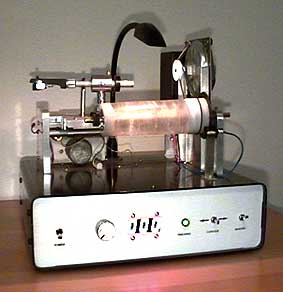 |
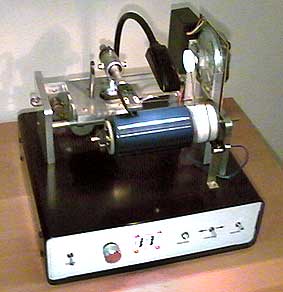 |
| Front view of the player - tone-arm in playback position. | Top view with tone-arm in playing position with Blue Amberol on mandrel. The tachometer speed pickup sensor (non-contact) is at the right of the mandrel. |
|
The picure above left shows a front view of my player. Toggle switches control "Power", "Carriage Left/Right" and "Mandrel". A two-color LED indicates tone-arm normal (green) and mis-tracking (red). When a tracking error is sensed by a optic-sensor, the arm is moved incrementally (about 0.5 mm "jumps") to the left to correct it, using a taut-band drive. Micro-switches at each end of the carriage travel prevent it from crashing into the ends of the machine, and damage the mechanism. The knob controls the volume for a small internal speaker, if needed. Next to this is the tachometer display which measures mandrel speed +/- 1 RPM over the machine's range of about 60 RPM to 250 RPM. A three step pulley, combined with an adjustable speed DC-powered AC variable frequency drive motor allows any speed in this range to be achieved. The mandrel itself is made of laminated Perspex, turned on a metal lathe. Dimensions for the mandrel were taken from my own Fireside machine's mandrel. A "DJ" lamp on a flexible gooseneck illuminates the works to assist in cueing the cylinder. The tone arm is simplicity itself - I chopped most of the length from an old straight-line tone-arm and make use of the head-shell socket for access to the Stanton 500 Mk2 cartridge. Two styli are available for playback:
A custom counterweight and tracking optic-sensor (hidden) under the carriage base completes the tracking components. |
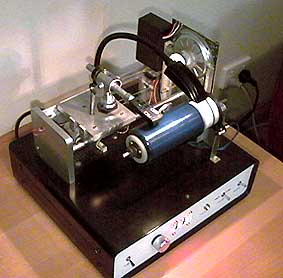 |
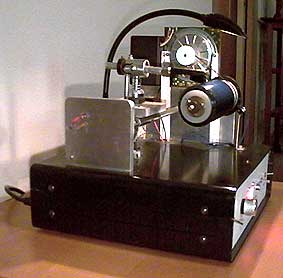 |
| Another top view with tone-arm in playing position with Blue Amberol on mandrel. The tachometer speed pickup slotted disc can be seen at the right of the mandrel. | Left end view showing mandrel bearing and some carriage detail. |
|
The optic-sensor under the carriage registers tone-arm mis-tracking in one direction only. Thus the tone arm "falls" from right to left across the cylinder. Flexible cable links the LED/sensor array to the control electronics inside the base. The advantage of a non-leadscrew drive is that shrunken celluloid (and wax) cylinders, with groove pitches which are no longer standard, can be played. The Dictaphone standard of 150 tpi can also be accommodated by such a system. A "nudge" facility to force carriage movement exists, if a locked groove is encountered, but the cost is some extra editing of the WAV file. The tracking motor (a small 6V DC tape recorder motor) is fed via a dual worm gear drive to the taut-band that moves the carriage and tone-arm. Four-way ultra-fine phono cartridge cable links the cartridge output to the upper RCA connectors on the back of the unit. A flat pre-amplifier boosts the signal to line level and this connects to the lower RCA connectors. This allows for ready connection to a PC sound-card for processing of recordings. An external speaker can be connected via the 3.5mm jack, for big-scale playback to an audience! |
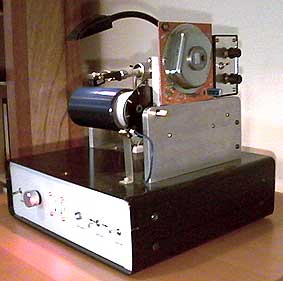 |
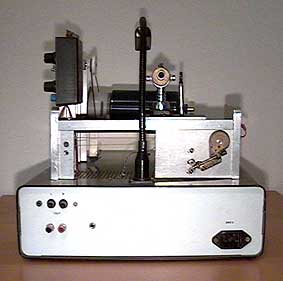 |
| Right end view showing mandrel drive motor and high/low speed range adjustment pots. The slotted disc provides rotational speed information to the digital tachometer circuits. | Rear view showing phono-cartridge outputs, and dual worm gear drive for the carriage. |
|
Further Improvements...
A heavier mandrel, turned from brass or soft iron, would decrease the remaining wow caused by the machine. This would only leave cylinder molding eccentricities which are very present in many Blue Amberols as a cause of surface-to-stylus speed variations. Just need to pay for it!!! :-) Making Use Of It - "Sonic Restoration" 1. Pre-amplification And Equalization: The output from my machine is a low-level (Stanton 500 Mk 2 moving magnet) signal, and is not directly usable. A pre-amp was a must, so I constructed a flat (non-RIAA) pre-amp to bring the signal up to line level and connected to the PC sound card input. Cylinders and all other early recordings were "equalized" by the mechanical characteristics of the system, not to the RIAA curve.
+9 to -15 dB at 60Hz, (rumble)
2. Software And Hardware For Audio Processing (2004 update): ...And the whole scene changed. I now use a PC-based system, but most of the functionality applies to Macintosh and Amiga machines. Please don't bombard me with "Mac's are better than PC's"...this isn't the place for such a discussion. Both platforms have their merits and problems. The internet eventually led me to Diamond Cut Audio Restoration Tools website, and version 1.58 of DC-ART. This ran well, but sadly the processing power affordable at the time (486DX33, 8 Meg RAM!) could only process as a background task. Several versions later DC-ART32 v 4.01 combined with a fast Pentium 4 3.0 Ghz system allows full real-time processing and "hear it as you go" previews!!! And Windows™ XP comes with a neat solitaire game... It's probably appropriate to continue the discussion of sonic restoration on a separate page...
Please note that Trevor Wayne Hill sadly passed away on 2nd July 2005.
|

| See the previous version of the Hill player: | Visit Trevor Hill's website: | |
